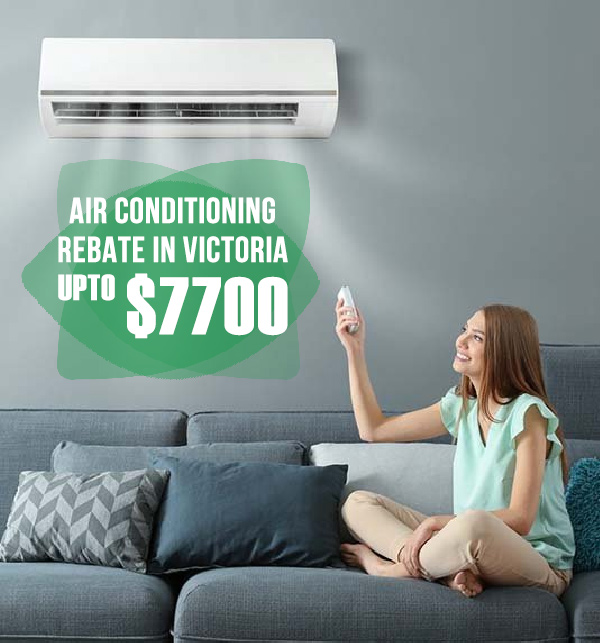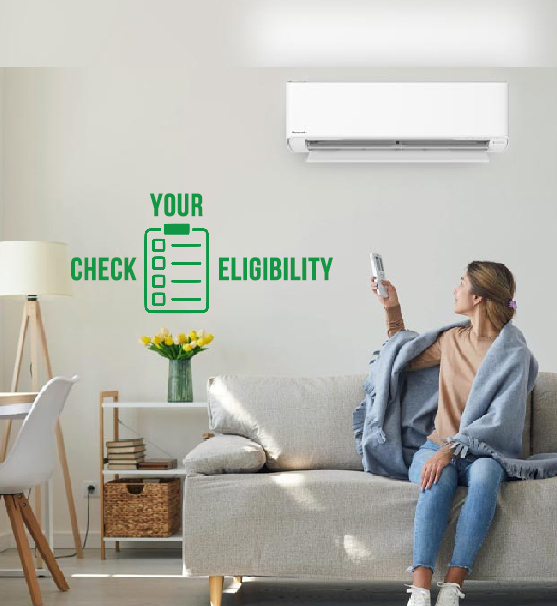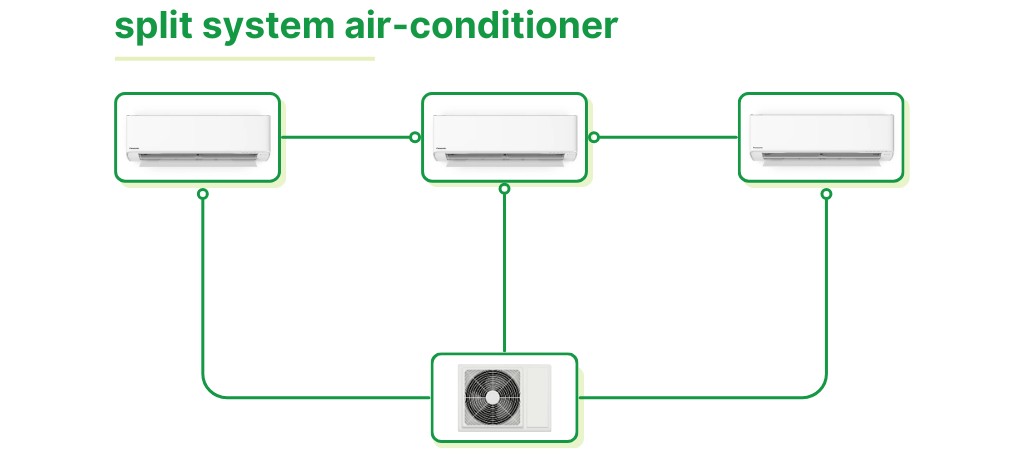Under the heating and cooling upgrades activity of the Victorian Energy Upgrades program, Victorian homeowners can receive between $1,000 to $7,700 in rebates for replacing an inefficient air conditioner with a brand new energy-efficient split system air conditioning unit.
An eligible Victorian household can replace any (or all) of the existing air-conditioner:
…with an energy-efficient reverse cycle (single or multi-split) air conditioner unit.

Your existing heating and cooling system and new, energy-efficent air conditioner(s) installed determines the amount of rebate available to you; this can be up to $7,700 in some cases.
You can use VEEC calculator to know the number of energy certificates generated from the upgrade activity at your home or business location.
The following tables show the approximate rebate/discount a Victorian household can expect (based on energy certificate price of $70).
| Existing Air Conditioner | New (Reverse Cycle) Air Conditioner | Approximate discount |
| Ducted (whole-of-house) gas heater | Four split systems installed in total: 8kW (one) 3kW (three) | Up to $2,520 |
| Non-ducted (room) gas heater | Single-split 3kW to 9kW air con | $560 to $1,400 |
| Central electric resistance ducted heater | Reverse cycle 10kW to 22.4kW air con | $5,040 to $7,700 |
| Ducted reverse cycle air conditioner | Reverse cycle air con of higher energy rating (10 kW to 22.4 kW) | $630 to $1,680 |
We have a dedicated team for split system air conditioning installation and support. During the entire process, we follow the rules of VEET Act, VEET regulations, and VEU guidelines.
The installation team includes the Victorian Building Authority (VBA) licensed plumbers and Energy Safe A-Grade incensed electricians.
All space heating and cooling upgrade activities undertaken by us under the VEU program are done in accordance with the provisions of the Electricity Safety Act 1998, the Gas Safety Act 1997, Plumbing Regulations 2018, the Occupational Health and Safety (OHS) Act, 2004 and the Building Act 1993.
We decommission the existing air conditioning system according to the program guidelines in a practical and safe manner to ensure it cannot be reused again.
Any waste generated from the replacement and installation is removed from the location and disposed of by our team in accordance with all applicable waste management requirements under the Environment Protection Act 2017 and its regulations and Environment Protection Regulations 20.
After the installation, our team will share the following documents with you:

All Victorian residents (including businesses) are eligible to apply for and receive rebates under the heating and cooling activity of the Victorian Energy Upgrades program.
The following conditions must be met to qualify for the rebates:
The following steps are involved in applying for the air conditioning rebate under the Victoria government VEU program:
Complete the online application form on our website
Schedule a free assessment at a time that works best for you. Based on the assessment, our team will offer a suitable reverse cycle air-conditioning product.
Our team of certified installers will install the system at your home/business.
Enjoy the benefits of improved energy efficiency and thermal comfort.

Unlike conventional cooling-only air conditioners, split-system air conditioners serve the dual purpose of heating and cooling a space.
The split system air conditioners are also called reverse cycle air conditioners because, in heating mode, the direction of flow of refrigerant is reversed and the roles of the indoor and outdoor coils are reversed. The evaporator coil of the indoor unit becomes the condenser coil, and the condenser coil of the outdoor unit becomes the evaporator coil.
During the cooling mode, a split system air conditioning system works as a conventional cooling-only air conditioner. After switching to the heating cycle, a reverse cycle air conditioner works similarly to an air-source heat pump.
An air conditioner using heat pump technology sources heat from the outdoor ambient air and transfers it to the condenser coil of the indoor blower unit (also known as the air handler).
Because heat pump-based heating and cooling systems do not create energy (they simply move energy from one place to another), such air conditioners are the most efficient type for space heating and cooling. For every unit of electricity used by a reverse cycle air conditioner, it can generate up to 6 units of heat.
To put things in perspective, conventional air conditioners can never produce 1 unit of heat for every unit of electricity used by them.
Split system air conditioners come in a range of sizes, heating or cooling outputs that are measured in kilowatts. To maximize energy efficiency and money savings, it is essential to pick the right-sized split-system air conditioning unit for space heating and cooling.
Only a properly sized air conditioning unit can offer optimal thermal comfort and maximum energy savings. Apart from economic benefits, better thermal comfort also brings social and health benefits.
The room/space size and insulation are the most important factors to consider when selecting a reverse cycle air con.
An oversized air conditioner for a room will result in the space getting too cold/hot, higher electricity bills, and inadequate dehumidification. On the contrary, an undersized split-system air conditioner takes a longer time to heat/cool a space, and it has to frequently run at maximum output to achieve thermal comfort. This reduces the lifespan of the air conditioning unit.
Getting a right-sized reverse cycle air con is easy if you’re getting it installed through the heating and cooling rebate program of the Victoria government.
The heating and cooling upgrades come under the Victorian Energy Upgrades (VEU) Program, a flagship energy-efficiency program run by the government of Victoria.
When you contact a VEU program accredited split system air conditioner installer, the installer will visit your home or workplace on the scheduled day, inspect the space where you’re planning to install the air con, and take the measurements of the room size and ceiling height.
The installer will also check windows, insulation, and home orientation. Based on the local climatic conditions, the installer will recommend a right-sized split system air-conditioner for the intended space.
We recommend the following air con sizes for the given room size:
| Room/space size | Air con capacity |
| Less than 20 meters square | 2.5 kW |
| 20 to 40 meters square | 2.5 to 5kW |
| 40 to 60 meters square | 4-6 kW |
| 60 to 80 meters square | 5-7 kW |
| Greater than 80 meters square | 6-9 kW |
Though modern reverse cycle split system air conditioners are more energy-efficient than traditional air conditioners, they still cost money to run.
Two major factors that affect the running cost of these air conditioners are the local climate and the size of the space they are heating or cooling to maintain a set temperature.
The running cost of split system air conditioners will be higher in regions with extreme temperatures. For example, in the Loddon Mallee region, the average maximum temperature reaches 30 degrees Celsius during the summer months, and the lowest mean maximum temperature drops to 3.2 degrees and 2.7 degrees Celsius in the cities of Ballarat and Greater Bendigo, respectively.
Similarly, a large space will require a split system air conditioning system to run longer in order to reach and maintain a set point temperature.
Here are a list of action a household/business can take to reduce the running cost of air conditioning:
Here are the advantages of installing reverse cycle air-conditioners under heating and cooling activity of VEU rebate program:
The following types of heating and cooling systems are eligible for replacement with an energy efficient split system air conditioning unit:
The split system air conditioners are the most efficient air conditioners for space heating and cooling. With gas heating in a three-bedroom home costing about $1,444.85 per year in South Australia, upgrading to a split system air conditioning system can reduce the costs to $476.61. The multi-split system air conditioner offers the ability to control the temperature of an indoor unit according to the thermal comfort needs of a space.
The lifespan of a split system air conditioner ranges between 15 and 20 years. The manufacturing quality of the parts, frequency of use, and maintenance are the determining factors.
First, you need to share the required details through the application form on this page. Once we receive the information, our team will contact you to confirm the details and discuss the decommissioning and installation schedule. Next, our team will visit your home or business location and inspect the site. The next step is decommissioning and installation. After the installation, the paperwork will be done.